Acasă » Practică medicală » Tranforming Growth Factor – BETA (TGF-β)/Bone One Morphogenic Protein (BMP) signaling in human diseases
Tranforming Growth Factor – BETA (TGF-β)/Bone One Morphogenic Protein (BMP) signaling in human diseases

Rezumat:
Acesta este un review al datelor din literatura de specialitate cu privire la cele mai recente descoperiri in ceea ce priveste intelegerea mecanismelor de semnalizare TGF-β/BMP de la nivelul celulei osoase ,din studiile genetice efectuate pe soareci si la nivelul patologiei umane cauzate de dereglari ale semnalizarii TGF-β/BMP.
Cuvinte cheie: os, mecanism de semnalizare TGF-β), mecanism de semnalizare BMP
Abstract:
This is a review of the literature data concerning the recent advances in our understanding of TGF-β/BMP signaling in bone from studies of genetic mouse models and human diseases caused by the disruption of TGF-β/BMP signaling.
Keywords: bone, TGF signaling, BMP signaling
Introduction
Transforming growth factor-beta (TGF-β)/bone morphogenic protein (BMP) signaling is involved in a vast majority of cellular processes and is fundamentally important throughout life. TGF-β/BMPs have widely recognized roles in bone formation during mammalian development and exhibit versatile regulatory functions in the body. Signaling transduction by TGF-β/BMPs is specifically through both canonical Smad-dependent pathways (TGF-β/BMP ligands, receptors and Smads) and non-canonical Smad-independent signaling pathway (e.g. p38 mitogen-activated protein kinase pathway, MAPK).
Following TGF-β/BMP induction, both the Smad and p38 MAPK pathways converge at the Runx2 gene to control mesenchymal precursor cell differentiation. The coordinated activity of Runx2 and TGF-β/BMP-activated Smads is critical for formation of the skeleton. Recent advances in molecular and genetic studies using gene targeting in mice enable a better understanding of TGF-β/BMP signaling in bone and in the signaling networks underlying osteoblast differentiation and bone formation.
The significance of TGF-β/BMP signaling in human diseases
A lot of progress has been made by the research studies which has contributed greatly to our understanding of human skeletal diseases caused by mutations related to TGF-β/BMP signaling. Among the pathologies is Fibrodysplasia ossificans progressiva (FOP) which is a rare disabling disease caused by mutations in ALK2 [1] and characterized by heterotopic ossification [2]. Mutations in BMPR1B were recently demonstrated in two affected families with brachydactyly type A2 (BDA2) [3]. BDA2 is characterized by hypoplasia/aplasia of the second middle phalanx of the index finger and sometimes the little finger. BDA2 was first described by Mohr and Wriedt in a large Danish/Norwegian kindred and GDF5 (growth and differentiation factor 5) was identified as a novel BDA2 causing gene[3,4]. Furthermore, two mutations (N445K, T) of GDF5 in patients developed synostosis syndrome [5].
An additional functional mechanism for the pathogenesis of BDA2 is duplication of a regulatory element that affects the expression of BMP2 in the developing limb [6]. Mutations in BMP antagonist NOGGIN cause brachydactyly type B (BDB), which is characterized by terminal deficiency of fingers and toes [7]. Mutations of Sost (antagonist of BMPs) are associated with sclerosteosis which is a disorder featuring increased bone density [8]. Mutations of the TGF-β1 gene on chromosome 19q13.1-q13.3 was reported to be the cause for camurati-engelmann disease (CED) characterized by bone pain and osteosclerosis affecting the diaphysis of long bones [9]. Recently, a new TGF-β1 mutation (E169K) in exon 2 was identified in a Chinese family [10] which developed CED.
Except for the skeletal disorder, disruptions of TGF-β/BMP signaling also cause other human diseases. BMP-15 defects are involved in the pathogenesis of hypergonadotropic ovarian failure in humans, which leads to female infertility [11]. Mutation of BMPRII is linked to the development of primary pulmonary hypertension (PPH) and features the widespread occlusion of small pulmonary arteries, which leads to sustained elevation of pulmonary arterial pressure [12]. Germline mutations of the gene encoding BMPR-IA results in juvenile polyposis, an autosomal dominant gastrointestinal hamartomatous polyposis syndrome in which patients are at risk for developing gastrointestinal cancers [13].
Moreover, BMPs have been implicated in periodontal disease [14], osteoarthritis [15], and the tumor metastasis. Indeed, BMP-2 may facilitate bone metastasis in gastric cancer [16]. These findings indicate the importance of TGF-β/BMPs signaling in bone development and homeostasis.
It is hoped that basic research on disease and its underlying mechanism may open new avenues for the generation of antagonists, small inhibitory molecules, or novel delivery systems that target bone diseases. A small molecule inhibitor of BMP type I receptor activity has been demonstrated to be useful in treating FOP and heterotopic ossification syndromes [17]. TGF-β type I receptor kinase inhibitor downregulates rheumatoid synoviocytes and prevents the arthritis [18].
TGF-β1-induced migration of bone mesenchymal stem cells couples bone resorption with formation, so modulation of TGF-β1 activity could be an effective treatment for bone remodeling diseases [19]. The delivery of TGF-β3 with an injectable calcium-phosphate matrix at the supraspinatus tendon footprint has promise to improve healing after soft tissue repair [20].
TGF-β /BMP signaling in clinical applications
Currently, two BMP products have been approved by the Food and Drug Administration (FDA) for clinical applications to treat fractures of long bones and improve intervertebral disk regeneration through a purified collagen matrix respectively infused with BMP-2 (Medtronic) or OP-1 BMP-7 (Stryker Biotech) and implanted at the site of the fracture. BMP treatment for acute open tibial fractures may be more favorable economically [21]. Combination of BMP-7 with a type-one collagen carrier has been the subject of increasing interest. BMP-7 in combination with osteosynthesis revision and bone grafting, or with bone grafting alone, shows that there is no perioperative or postoperative complications in patients[22].
The application of BMP-7 in a total of 19 joint fusions (ankle, subtalar, talonavicular, pubic and sacroiliac) resulted in healing rates of 90% and satisfactory subjective functional outcome in 70% of cases [23].
With the use of BMPs increasingly accepted in spinal fusion surgeries, other therapeutic approaches targeting BMP signaling are emerging beyond applications to skeletal disorders. BMP-7 is also regarded as a strong candidate for the clinical treatment of chronic kidney disease (CKD) [24].
Administration of BMP-7 prevents the development of adynamic bone disease in a preclinical model of chronic kidney failure [25]. TGF-β/BMPs have also been used as the prognostic biomarkers. For instance, GDF-15 has emerged as a prognostic biomarker in acute coronary syndrome trial populations [26] and in cardiac and vascular dysfunction and disease [27]. GDF-11 may be a novel diagnostic and prognostic biomarker in patients with colorectal cancer [28].
Additionally, GDF-5 has emerged as a therapeutic target for rheumatic diseases [29]. Recent applications graft BMP peptides corresponding to residues 73-92, 89-117, and 68-87 of BMP-2, BMP-7, and BMP-9 as adhesion peptides (GRGDSPC) onto polyethylene terephthatalate (PET) surfaces to enhance osteogenic differentiation and mineralization of pre-osteoblastic cells [30]. These engineered biomaterials for enhanced bone regneration are in the initial trial stage of development.
Our understanding of bone is rapidly advancing with the use of new technology, such as conditional knockout mice, high-throughput screening, and the discovery of newly recognized cross-talk between TGF-β/BMP signaling and many other major signaling pathways such as MAPK, Wnt, Hedgehog, Notch, and FGF. TGF-β/BMP signaling plays critical regulatory functions in osteoblast differentiation and bone formation. The signaling relays in each stage (ligands, receptors, Smads) are responsible for the final target gene expression. Perturbations of TGF-β/BMP signaling result in various clinical disorders including cancers, bone diseases, and vascular diseases.
Conclusion
There is great potential for the clinical applications of TGF-β/BMP molecules for the treatment of bone-related diseases, such as FOP, chronic kidney disease, brachydactyly type A2, and osteoporosis. More importantly, with the aging population expected to double over the next decade, the number of people suffering from osteoporosis is likely to increase dramatically and so is the cost of Medicare.
Since the current cost of medical care associated with osteoporosis (especially hip fractures) has been estimated at more than $17 billion a year, there is increased pressure to elucidate the pathophysiology of bone diseases and the molecular mechanisms of skeletal remodeling in health and disease.
So far, BMP-2-and BMP-7-containing osteogenic implants have been used in over one million patients worldwide for the treatment of long bone nonunions, spinal fusions, and acute fractures.
Apart from their recognized role in bone regeneration, BMPs have been used systemically to improve skeletal volume, kidney regeneration, glucose, and iron metabolism. There are still much to discover, including small molecule inhibitors with special target sites and better effectiveness, as well as better delivery systems and reliable TGF-β/BMPs retention at target sites in vivo.
References:
1. Kaplan FS, Pignolo RJ, Shore EM. The FOP metamorphogene encodes a novel type I receptor that dysregulates BMP signaling. Cytokine Growth Factor Rev. 2009;20:399-407;
2. Katagiri T. [Genetic basis for skeletal disease. Establishment of novel treatments for fibrodysplasia ossificans progressiva (FOP)]. Clin Calcium. 2010;20:1204-11;
3. Kjaer KW, Eiberg H, Hansen L, van der Hagen CB, Rosendahl K, Tommerup N. et al. A mutation in the receptor binding site of GDF5 causes Mohr-Wriedt brachydactyly type A2. J Med Genet. 2006;43:225-31;
4. Seemann P, Schwappacher R, Kjaer KW, Krakow D, Lehmann K, Dawson K. et al. Activating and deactivating mutations in the receptor interaction site of GDF5 cause symphalangism or brachydactyly type A2. J Clin Invest. 2005;115:2373-81;
5. Seemann P, Brehm A, Konig J, Reissner C, Stricker S, Kuss P. et al. Mutations in GDF5 reveal a key residue mediating BMP inhibition by NOGGIN. PLoS Genet. 2009;5:e1000747;
6. Dathe K, Kjaer KW, Brehm A, Meinecke P, Nurnberg P, Neto JC. et al. Duplications involving a conserved regulatory element downstream of BMP2 are associated with brachydactyly type A2. Am J Hum Genet. 2009;84:483-92;
7. Lehmann K, Seemann P, Silan F, Goecke TO, Irgang S, Kjaer KW. et al. A new subtype of brachydactyly type B caused by point mutations in the bone morphogenetic protein antagonist NOGGIN. Am J Hum Genet. 2007;81:388-96;
8. Brunkow ME, Gardner JC, Van Ness J, Paeper BW, Kovacevich BR, Proll S. et al. Bone dysplasia sclerosteosis results from loss of the SOST gene product, a novel cystine knot-containing protein. Am J Hum Genet. 2001;68:577-89;
9. Campos-Xavier B, Saraiva JM, Savarirayan R, Verloes A, Feingold J, Faivre L. et al. Phenotypic variability at the TGF-beta1 locus in Camurati-Engelmann disease. Hum Genet. 2001;109:653-8;
10. Wu S, Liang S, Yan Y, Wang Y, Li F, Deng Y. et al. A novel mutation of TGF beta1 in a Chinese family with Camurati-Engelmann disease. Bone. 2007;40:1630-4;
11. Di Pasquale E, Beck-Peccoz P, Persani L. Hypergonadotropic ovarian failure associated with an inherited mutation of human bone morphogenetic protein-15 (BMP15) gene. Am J Hum Genet. 2004;75:106-11;
12. Lane KB, Machado RD, Pauciulo MW, Thomson JR, Phillips JA 3rd, Loyd JE. et al. Heterozygous germline mutations in BMPR2, encoding a TGF-beta receptor, cause familial primary pulmonary hypertension. Nat Genet. 2000;26:81-4;
13. Howe JR, Bair JL, Sayed MG, Anderson ME, Mitros FA, Petersen GM. et al. Germline mutations of the gene encoding bone morphogenetic protein receptor 1A in juvenile polyposis. Nat Genet. 2001;28:184-7;
14. Li Y, Messina C, Bendaoud M, Fine DH, Schreiner H, Tsiagbe VK. Adaptive immune response in osteoclastic bone resorption induced by orally administered Aggregatibacter actinomycetemcomitans in a rat model of periodontal disease. Mol Oral Microbiol. 2010;25:275-92;
15. Valdes AM, Spector TD. The clinical relevance of genetic susceptibility to osteoarthritis. Best Pract Res Clin Rheumatol. 2010;24:3-14;
16. Park Y, Kim JW, Kim DS, Kim EB, Park SJ, Park JY. et al. The Bone Morphogenesis Protein-2 (BMP-2) is associated with progression to metastatic disease in gastric cancer. Cancer Res Treat. 2008;40:127-32;
17. Yu PB, Deng DY, Lai CS, Hong CC, Cuny GD, Bouxsein ML. et al. BMP type I receptor inhibition reduces heterotopic [corrected] ossification. Nat Med. 2008;14:1363-9;
18. Sakuma M, Hatsushika K, Koyama K, Katoh R, Ando T, Watanabe Y. et al. TGF-beta type I receptor kinase inhibitor down-regulates rheumatoid synoviocytes and prevents the arthritis induced by type II collagen antibody. Int Immunol. 2007;19:117-26;
19. Tang Y, Wu X, Lei W, Pang L, Wan C, Shi Z. et al. TGF-beta1-induced migration of bone mesenchymal stem cells couples bone resorption with formation. Nat Med. 2009;15:757-65;
20. Kovacevic D, Fox AJ, Bedi A, Ying L, Deng XH, Warren RF. et al. Calcium-phosphate matrix with or without TGF-beta3 improves tendon-bone healing after rotator cuff repair. Am J Sports Med. 2011;39:811-9;
21. Garrison KR, Shemilt I, Donell S, Ryder JJ, Mugford M, Harvey I. et al. Bone morphogenetic protein (BMP) for fracture healing in adults. Cochrane Database Syst Rev. 2010:CD006950;
22. Moghaddam A, Elleser C, Biglari B, Wentzensen A, Zimmermann G. Clinical application of BMP 7 in long bone non-unions. Arch Orthop Trauma Surg. 2010;130:71-6;
23. Kanakaris NK, Mallina R, Calori GM, Kontakis G, Giannoudis PV. Use of bone morphogenetic proteins in arthrodesis: clinical results. Injury. 2009;40(Suppl 3):S62-6;
24. Mathew S, Davies M, Lund R, Saab G, Hruska KA. Function and effect of bone morphogenetic protein-7 in kidney bone and the bone-vascular links in chronic kidney disease. Eur J Clin Invest. 2006;36(Suppl 2):43-50;
25. Zeisberg M, Kalluri R. Reversal of experimental renal fibrosis by BMP7 provides insights into novel therapeutic strategies for chronic kidney disease. Pediatr Nephrol. 2008;23:1395-8;
26. Kempf T, Sinning JM, Quint A, Bickel C, Sinning C, Wild PS. et al. Growth-differentiation factor-15 for risk stratification in patients with stable and unstable coronary heart disease: results from the AtheroGene study. Circ Cardiovasc Genet. 2009;2:286-92;
27. Kempf T, Wollert KC. Growth differentiation factor-15: a new biomarker in cardiovascular disease. Herz. 2009;34:594-9;
28. Yokoe T, Ohmachi T, Inoue H, Mimori K, Tanaka F, Kusunoki M. et al. Clinical significance of growth differentiation factor 11 in colorectal cancer. Int J Oncol. 2007;31:1097-101;
29. Lories RJ, Luyten FP. Bone morphogenetic protein signaling in joint homeostasis and disease. Cytokine Growth Factor Rev. 2005;16:287-98;
30. Zouani OF, Chollet C, Guillotin B, Durrieu MC. Differentiation of pre-osteoblast cells on poly(ethylene terephthalate) grafted with RGD and/or BMPs mimetic peptides. Biomaterials. 2010Nov;31(32):8245-53.
Fii conectat la noutățile și descoperirile din domeniul medico-farmaceutic!
Utilizam datele tale in scopul corespondentei si pentru comunicari comerciale. Pentru a citi mai multe informatii apasa aici.







